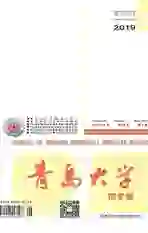AngⅡ上调TRPC6、NFAT2介导2型糖尿病肾病 足细胞损伤
2019-09-10李明慧马瑞霞阎文静张岩王莹
李明慧 马瑞霞 阎文静 张岩 王莹



[摘要]目的探討瞬时受体电位阳离子通道蛋白6(TRPC6)、活化T细胞核因子2(NFAT2)参与血管紧张素Ⅱ(AngⅡ)介导的2型糖尿病肾病足细胞损伤的可能机制。方法制备2型糖尿病大鼠模型,随机分为糖尿病组(DM组,n=11)、缬沙坦组(ARB组,n=11),同时设置正常对照组(NC组,n=10),ARB组给予缬沙坦40 mg/(kg·d)灌胃,DM组及NC组给予等量生理盐水灌胃,干预12周后检测各组尿清蛋白排泄率(UAE),光镜、电镜下观察肾脏及足细胞病理改变,Western blot方法测定AngⅡ、NFAT2及TRPC6蛋白的表达水平。结果DM组UAE显著高于NC组(F=261.834,t=22.80,P<0.01),ARB组UAE水平显著低于DM组(t=13.08,P<0.01)。光镜下可见,DM组较NC组肾小球体积增大、肾基底膜增厚、系膜细胞及系膜基质增生;电镜下可见,DM组足细胞数量减少,足突融合、消失,ARB组上述病变较DM组明显减轻。与NC组相比,DM组AngⅡ、NFAT2、TRPC6蛋白表达水平均显著升高(F=290.888~639.364,t=15.00~29.50,P<0.01),ARB组较DM组明显减低(t=22.81~34.01,P<0.01)。结论AngⅡ可能通过上调TRPC6、NFAT2介导2型糖尿病足细胞损伤。
[关键词]糖尿病肾病;足细胞;血管紧张素Ⅱ;TRPC阳离子通道;NFATC转录因子类
[中图分类号]R587.24[文献标志码]A[文章编号]2096-5532(2019)03-0299-05
[ABSTRACT]ObjectiveTo investigate the possible mechanism of transient receptor potential cation channel 6 (TRPC6) and nuclear factor of activated T-cells 2 (NFAT2) in podocyte injury mediated by angiotensin Ⅱ (AngⅡ) in type 2 diabetic nephropathy. MethodsA rat model of type 2 diabetes was established, and then these rats were randomly divided into diabetes mellitus (DM) group with 11 rats and valsartan group (ARB group) with 11 rats. A total of 10 normal rats were enrolled as normal control group (NC group). The rats in the ARB group were given valsartan 40 mg/(kg·d) by gavage, and those in the DM group and the NC group were given an equal volume of normal saline by gavage. After 12 weeks of intervention, urinary albumin excretion (UAE) rate was measured; pathological changes of the kidney and podocytes were observed under a light microscope and an electron microscope; Western blot was used to measure the protein expression of AngⅡ, NFAT2, and TRPC6. ResultsThe DM group had a significantly higher level of UAE than the NC group (F=261.834,t=22.80,P<0.01), and the ARB group had a significantly lower level of UAE than the DM group (t=13.08,P<0.01). Compared with the NC group under a light microscope, the DM group had significant increases in glomerular volume and glomerular basement membrane thickness, with marked proliferation of mesangial cells and mesangial matrix; compared with the NC group under an electron microscope, the DM group had a significant reduction in the number of podocytes, with foot process fusion and disappearance. The ARB group had significantly lower severities of the above pathological changes than the DM group. Compared with the NC group, the DM group had significant increases in the protein expression of AngⅡ, NFAT2, and TRPC6 (F=290.888-639.364,t=15.00-29.50,P<0.01), and the ARB group had significantly lower expression than the DM group (t=22.81-34.01,P<0.01). ConclusionAngⅡ may mediate podocyte injury in type 2 diabetes by upregulating TRPC6 and NFAT2.
[KEY WORDS]diabetic nephropathies; podocytes; angiotensin Ⅱ; TRPC6 cation channel; NFATC transcription factors
目前,糖尿病肾病(DN)已经成为终末期肾脏病(ESRD)的主要原因之一[1],而足细胞损伤与其发生发展有密切相关性[2]。肾素-血管紧张素-醛固酮(RAAS)系统的激活在足细胞损伤中有重要的作用,血管紧张素Ⅱ(AngⅡ)在高糖刺激的足细胞中表达明显增多[3]。此外,瞬时受体电位阳离子通道蛋白6(TRPC6)、活化T细胞核因子2(NFAT2)也参与了DN足细胞损伤[4-5]。足细胞实验发现,AngⅡ可通过调控TRPC6、NFAT2表达介导足细胞损伤[3,6],但目前少有体内实验证实此通路,且其具体机制尚不明确。本课题拟通过动物实验证实AngⅡ是否通过影响TRPC6、NFAT2表达促进DN足细胞损伤,并进一步探讨可能的机制。
1材料及方法
1.1动物分组及处理
SPF级、体质量(200±20)g、8周龄雄性Wistar大鼠40只(青岛市药检所实验动物中心),随机分为正常对照组(n=10)及实验组(n=30)。实验组参照文献方法[7]建立2型糖尿病(T2DM)大鼠模型,22只大鼠建模成功,成功率73.3%。将T2DM模型大鼠随机分为2组,各11例。缬沙坦组(ARB组)给予缬沙坦40 mg/(kg·d)灌胃,糖尿病组(DM组)给予等量生理盐水灌胃,干预12周。
1.2生化指标检测
干预12周后测定大鼠体质量,测鼠尾血压(SBP),收集鼠尾静脉血,代谢笼收集24 h尿液标本,处死大鼠,收集肾脏标本,测定空腹血糖(FBG)、胆固醇(CH)、三酰甘油(TG)、血肌酐(Scr)、尿素氮(BUN)、尿清蛋白排泄率(UAE)、尿肌酐(Ucr),计算内生肌酐清除率(Ccr=Ucr/Scr×24 h尿量)、肾小球指数(肾质量/体质量,KW/BW)、胰岛素敏感指数(ISI,ISI=22.5/(FBG×FINs),HOMA法)。
1.3肾脏病理学观察
应用40 g/L多聚甲醛固定肾组织,经脱水、二甲苯透明、石蜡包埋、切片后PAS染色,光镜下观察肾组织病理学变化。用25 g/L戊二醛固定肾组织,脱水、包埋、切片、醋酸铀-柠檬酸铅染色,透射电镜(JEM-1200)下观察足细胞超微结构的变化。
1.4Western blot方法检测AngⅡ、NFAT2及TRPC6的表达
裂解肾皮质、提取总蛋白,经十二烷基硫酸钠聚丙烯酰胺凝胶电泳分离蛋白,然后转移至硝酸纤维素膜上,50 g/L脱脂奶粉封闭,加入AngⅡ(兔抗鼠,1∶1 000)、TRPC6(羊抗鼠,1∶500)、NFAT(鼠抗鼠,1∶2 000)抗体及及内参GAPDH抗体(1∶2 000),4 ℃孵育过夜后加入二抗常温孵育。应用化学发光凝胶成像系统进行AngⅡ、NFAT2及TRPC6蛋白显色的吸光度值分析。
1.5统计学分析
应用SPSS 23.0软件进行统计学分析,计量资料结果以±s形式表示,多组间比较应用单因素方差分析,组间两两比较采用LSD方法。以P<0.05为差异有统计学意义。
2结果
2.1各组大鼠生化指标比较
DM组大鼠FBG、TG、CH、Ccr、SBP、UAE、KW/BW均高于NC组(F=63.340~1 871.388,t=10.38~54.59,P<0.01),DM组ISI显著低于DM组(F=449.825,t=26.57,P<0.01)。ARB组大鼠FBG、KW/BW、UAE与DM组比较均明显降低(t=3.38~13.08,P<0.01)。见表1。
2.2各组肾脏病理表现
光镜下观察,NC组大鼠肾组织结构完整清晰;DM组大鼠肾小球体积明显增大,系膜细胞及系膜基质增生,基底膜增厚;ARB组病理改变较DM组明显减轻。
2.3足细胞超微结构
电镜下可见,NC组足细胞结构完整清晰,足突排列整齐,基底膜均匀;DM组足细胞足突融合、消失,基底膜弥漫增厚;ARB组上述病变较DM组明显减轻。见图1。
2.4各组肾脏AngⅡ、TRPC6和NFAT2蛋白表达比较
DM组AngⅡ、TRPC6、NFAT2蛋白表达较NC组均明显增加,差异有显著性(F=290.888~639.364,t=5.00~29.50, P<0.01),ARB组较DM组明显减低,差异有显著性(t=22.81~34.01,P<0.01)。见图2、表2。
3討论
DN发展过程中伴随着足细胞数目减少及足突消失、融合等病理改变,足细胞损伤导致了蛋白尿产生[8-9]。已有研究结果显示,足细胞损伤与自噬、巨噬细胞浸润、氧化应激及RAS系统激活等因素密切相关[10-13],其中肾脏局部RAS激活发挥了重要的作用[14]。DURVASULA等[15]的研究发现,高糖刺激下足细胞AngⅡ的表达明显上调;LIN 等[16]研究显示,1型DN大鼠肾脏AngⅡ表达增加。本文结果显示,T2DM大鼠肾脏AngⅡ蛋白表达升高,缬沙坦干预后AngⅡ蛋白表达减少,同时UAE下降,足细胞病变缓解。由此可见,肾脏局部AngⅡ上调在DN足细胞损伤中发挥了重要的作用。AngⅡ介导足细胞损伤的机制复杂,可能与TRPC6、NFAT2相关[17-18]。
TRPC6是一种非选择性钙离子通道蛋白,通过介导Ca2+内流发挥作用[19-21]。足细胞中TRPC6与nephrin、podocin、CD2AP 形成裂孔隔膜(SD)复合体,共同维持足细胞结构、功能的完整性[22]。近年来有研究发现,TRPC6与DN足细胞损伤密切相关[23]。SONNEVELD等[24]体外实验发现,高糖环境可通过刺激足细胞产生AngⅡ上调TRPC6的表达,从而促进足细胞损伤,该实验将AngⅡ/TRPC6通路定位至足细胞。本文的研究结果显示,DN组大鼠TRPC6表达水平较NC组上调,应用缬沙坦干预后TRPC6表达明显减少,蛋白尿减少,足细胞病变减轻,提示在2型DN中AngⅡ可能通过上调TRPC6表达介导足细胞损伤。NFAT2是Ca2+/钙调磷酸酶(CaN)依赖的核转录因子,被激活后向细胞核内移位,调控靶基因转录[25-26]。近年来多项研究表明,NFAT2参与糖尿病足细胞损伤。LI等[27]研究显示,高糖刺激下细胞核内NFAT2水平显著增加,足细胞凋亡增多,高糖促进足细胞凋亡的作用可被NFAT2拮抗剂11R-VIVIT阻断。有动物实验结果显示,NFAT2在2型DN大鼠模型肾组织中的表达明显上调[7],本实验结果与其一致。为进一步探讨AngⅡ与NFAT2是否相互联系、共同促进糖尿病足细胞损伤,本文应用缬沙坦拮抗AngⅡ后观察肾脏NFAT2表达变化,结果显示NFAT2表达较DM组明显降低,提示2型DN中AngⅡ通过影响NFAT2的表达介导足细胞损伤。
本研究结果还显示,DN中AngⅡ通过影响NFAT2、TRPC6表达水平促进足细胞损伤,但在该过程中NFAT2与TRPC6是否存在联系有待进一步研究。已有研究发现,在心肌细胞中AngⅡ可通过激活TRPC6-NFAT2反馈环导致细胞肥大[28],亦有研究证实该正反馈机制同样存在于足细胞中[18]。具体机制可能为:AngⅡ作用于其AT1受体后,激活磷酯酶,将磷酯酰肌醇 4,5-二磷酸盐(PIP2)水解为1,4,5-三磷酸肌醇(IP3)和二脂酰甘油(DAG),促进Ca2+的释放和蛋白激酶C(PKC)的激活[29]。PKC可以进一步活化TRPC6,升高细胞内的Ca2+浓度[30]。NFAT2的激活依赖Ca2+/CaN,NFAT2被激活后发生核转位,调控下游靶基因转录[31]。在以后研究中,可应用TRPC6阻断剂干预T2DM大鼠,观察其AngⅡ、TRPC6和NFAT2的表达,进一步探讨TRPC6与NFAT2的相互作用。
总之,AngⅡ可能通过上调NFAT2、TRPC6表达参与DN足细胞损伤,为DN发病机制的研究提供了理论基础。
[参考文献]
[1]GNUDI L, COWARD R J, LONG D A. Diabetic nephropathy: perspective on novel molecular mechanisms[J]. Trends in Endocrinology and Metabolism: TEM, 2016,27(11):820-830.
[2]SHAKEEL M. Recent advances in understanding the role of oxidative stress in diabetic neuropathy[J]. Diabetes & Metabolic Syndrome, 2014,9(4):373-378.
[3]姚丹丹,马瑞霞,翟丽慧,等. 足细胞损伤的诱导途径:血管紧张素Ⅱ-足细胞瞬时受体电位阳离子通道蛋白6信号通路[J]. 中国组织工程研究, 2014,18(46):7447-7451.
[4]朱晓娜,王玉环,吴娟娟,等. VEGF及TRPC6的表达与糖尿病肾病大鼠足细胞损伤的相关机制[J]. 南方医科大学学报, 2018,38(3):1270-1276.
[5]何朝生,史伟,李锐钊,等. NFAT2参与高糖诱导的大鼠足细胞凋亡[J]. 南方医科大学学报, 2018,38(10):1270-1276.
[6]CHI X G, HU H B, YU S Y, et al. Losartan treating podocyte injury induced by Ang Ⅱ via downregulation of TRPC6 in podocytes[J]. Journal of the Renin-Angiotensin-Aldosterone System, 2015,16(4):1118-1124.
[7]MA Ruixia, LIU Liqiu, JIANG Wei, et al. FK506 ameliorates podocyte injury in type 2 diabetic nephropathy by down-regulating TRPC6 and NFAT expression[J]. International Journal of Clinical and Experimental Pathology, 2015,8(11):14063-14074.
[8]SIDDIQI F S, MAJUMDER S, THAI K, et al. The histone methyltransferase enzyme enhancer of zeste homolog 2 protects against podocyte oxidative stress and renal injury in diabetes[J]. Journal of the American Society of Nephrology, 2016,27(7):2021-2034.
[9]MINER J H. Podocyte biology in 2015 new insights into the mechanisms of podocyte health[J]. Nature Reviews Nephrology, 2016,12(2):63-64.
[10]方錢华,李春君. 足细胞自噬与糖尿病肾病[J]. 国际内分泌代谢杂志, 2017,37(4):1673-1675.
[11]郭银凤,赵宇,姜彧滕,等. 巨噬细胞诱导糖尿病肾病足细胞凋亡及其机制[J]. 中华内分泌代谢杂志, 2017,33(8):680-682.
[12]GORIN Y, CAVAGLIERI R C, KHAZIM K, et al. Targeting NADPH oxidase with a novel dual Nox1/Nox4 inhibitor atte-nuates renal pathology in type 1 diabetes[J]. American Journal of Physiology—Renal Physiology, 2015,308(11): F1276-F1287.
[13]陶娱,马屹茕,梁伟,等. 线粒体损伤在糖尿病肾病中的研究进展[J]. 中华肾脏病杂志, 2018,34(10):1001-7097.
[14]RAHIMI Z. The role of renin angiotensin aldosterone system genes in diabetic nephropathy[J]. Canadian Journal of Diabetes, 2015,40(2):178-183.
[15]DURVASULA R V, SHANKLAND S J. Activation of a local renin angiotensin system in podocytes by glucose[J]. American Journal of Physiology—Renal Physiology, 2008,294(4): F830-F839.
[16]ZHANG Lin, AN Xiaofei, RUAN Xin, et al. Inhibition of (pro)renin receptor contributes to renoprotective effects of Angiotensin Ⅱ type 1 receptor blockade in diabetic nephropathy[J]. Frontiers in Physiology, 2017,8:758..
[17]ILATOVSKAYA D V, LEVCHENKO V, LOWING A A, et al. Podocyte injury in diabetic nephropathy: implications of angiotensin Ⅱ-dependent activation of TRPC channels[J]. Scientific Reports, 2015,5(1):10.
[18]NIJENHUIS T, SLOAN A J, HOENDEROP J G, et al. Angiotensin Ⅱ contributes to podocyte injury by increasing TRPC6 expression via an NFAT-mediated positive feedback signaling pathway[J]. The American Journal of Pathology, 2011,179(4):1719-1732.
[19]YANG Lili, LIU Bingchen, LU Xiaoyu, et al. Inhibition of TRPC6 reduces non-small cell lung cancer cell proliferation and invasion[J]. Oncotarget, 2017,8(3):5123-5134.
[20]HUANG Haiting, LIN Xu, YOU Yanwu, et al. Inhibition of TRPC6 signal pathway alleviates podocyte injury induced by TGF-beta 1[J]. Cellular Physiology and Biochemistry, 2017,41(1):163-172.
[21]YAO Xingmei, LIU Yujun, WANG Yunman, et al. Astragaloside Ⅳ prevents high glucose-induced podocyte apoptosis via downregulation of TRPC6[J]. Molecular Medicine Reports, 2016,13(6):5149-5156.
[22]ILATOVSKAYA D V, STARUSCHENKO A. TRPC6 Channel as an emerging determinant of the podocyte injury susceptibility in kidney diseases[J]. American Journal of Physiology—Renal Physiology, 2015,309(5): F393-F397.
[23]SZABO T, AMBRUS L, ZAKANY N, et al. Regulation of TRPC6 ion channels in podocytes implications for focal segmental glomerulosclerosis and acquired forms of proteinuric diseases[J]. Acta Physiologica Hungarica, 2015,102(3):241-251.
[24]SONNEVELD R, JOHAN V V, BALTISSEN M A, et al. Glucose specifically regulates TRPC6 expression in the podocyte in an AngⅡ-dependent manner[J]. The American Journal of Pathology, 2014,184(6):1715-1726.
[25]BENDICKOVA K, TIDU F, FRIC J. Calcineurin-NFAT signalling in myeloid leucocytes: new prospects and pitfalls in immunosuppressive therapy[J]. EMBO Molecular Medicine, 2017,9(8):990-999.
[26]郭建路,康品方,陶敏,等. CaN/NFAT3信號通路与心血管疾病研究进展[J]. 中国老年学杂志, 2018,38(15):222-225.
[27]LI Ruizhao, ZHANG Li, SHI Wei, et al. NFAT2 mediates high glucose-induced glomerular podocyte apoptosis through increased Bax expression[J]. Experimental Cell Research, 2013,319(7):992-1000.
[28]KUWAHARA K, WANG Y G, MCANALLY J, et al. TRPC6 fulfills a calcineurin signaling circuit during pathologic cardiac remodeling[J]. Journal of Clinical Investigation, 2006,116(12):3114-3126.
[29]田超,范方田,陈文星,等. 血管紧张素Ⅱ及其1型受体在肿瘤血管生成中的作用研究进展[J]. 中国药理学通报, 2014,30(5):608-611.
[30]蔡佳盈,沈世忠,万建新. 瞬时受体电位通道蛋白6参与血管紧张素Ⅱ诱导足细胞损伤的信号传导机制[J]. 肾脏病与透析肾移植杂志, 2014,23(5):458-461,448.
(本文编辑 黄建乡)
